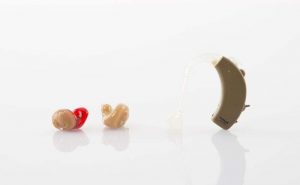There are many classification methods for deafness. According to the nature of the lesion, it can be divided into organic deafness and functional deafness. The former has organic lesions of the auditory system, and the latter does not. According to the lesion lesions can be divided into conductive sputum, neurological deafness and mixed deafness. According to the time of onset, it can be divided into congenital deafness and acquired deafness. According to the cause of the disease, it can be divided into hereditary deafness and acquired deafness.
1. Hereditary deafness
According to relevant statistics, hereditary spastic patients account for 50% of all deaf patients. However, due to the complexity of genetic methods, some manifestations are vertical transmission, and some are horizontal transmission; some are continuous morbidity, some are genetic generation; some parents have normal hearing, but children have hearing impairment, some parents have deafness, and children have normal hearing. Therefore, accurate judgment of hereditary paralysis is often difficult and sometimes masked by other symptoms. At this time, the tracking of family history is very important. Deafness caused by genetic factors may be structural abnormalities of the auditory organs such as auricular deformities, external auditory canal atresia, etc., or may be functional abnormalities, both conductive sputum and sensory neuropathic sputum. Some children with deafness also have other systemic abnormalities in the body, forming a characteristic clinical syndrome.
White forehead syndrome, the basic characteristics of white forehead hair, eyes or a translucent blue, that is, iris infection, the skin can be seen in areas lacking pigmentation. The three-body syndrome is also known as congenital stupid type. It has a special face and intellectual developmental disorder. The eye distance is wide and the eye is cracked. The lower side of the two eyes are lower than the lower outer ear, and the head circumference is smaller than normal.
Hereditary sputum does not necessarily manifest as congenital convulsions. Some hereditary babies have normal hearing after birth, and only when they reach a certain age, they show the characteristics of deafness. For example, familial sex neuropathic paralysis is an autosomal dominant genetic disease. The child is hearing and unobstructed after birth. It is only about 10 years old that symptoms begin to appear and increase year by year. At present, deafness gene detection technology contributes to the diagnosis of such deafness.

2. Acquired deafness
Acquired deafness is mainly caused by environmental factors such as diseases and drug toxicities. Viral infectious diseases: During pregnancy, some pathogenic microorganisms such as rubella virus, measles virus, herpes simplex virus, herpes zoster virus, cytomegalovirus, influenza bacillus, and Treponema pallidum can cause the development of fetal hearing organs. abnormal. Among them, the most invasive is the rubella virus. According to some statistics, during the first three months of pregnancy, the mother is infected with rubella, and the probability of deafness in neonates can reach 60%.
Although the medical conditions have improved in recent years, the incidence of infectious sputum has decreased significantly. However, the degree of such deafness is generally heavy and difficult to treat, and should still be highly valued. Common infectious diseases with serious hearing impairment are: meningitis, typhoid fever, scarlet fever, mumps, viral hepatitis, viral pneumonia, polio and so on.
During pregnancy, if you have diabetes, chronic nephritis, high blood pressure, severe anemia, hypothyroidism, carbon monoxide poisoning, alcoholism, and major mental trauma, severe malnutrition, etc. may also cause fetal hearing loss. When the newborn is severely suffocated, the first thing that is affected is the auditory organ. Therefore, the length of labor, the use of oxytocin, the presence of meconium in the amniotic fluid, the presence or absence of umbilical cord around the neck after birth, the presence or absence of bruising on the skin, and how long The details of the crying and other births should be fully noticed. The fetus was not born smoothly, was forced to use the induction device, head trauma such as fetal head suction, forceps, etc., or manual induction of too rough, can also damage the auditory organs or auditory center, leading to deafness.
Newborns born after 37 weeks of gestation are called premature babies. At birth, the body weight is less than 2500 g, which is called low birth weight. A large number of clinical data prove that premature and low birth weight children are more prone to hearing impairment and should be fully paid attention. 2 ~ 3 days after the birth of a normal newborn, jaundice begins to appear, and 10 ~ 14 disappears after a day, called physiological jaundice. If the jaundice appears too early or subsides too late to become pathological jaundice, it is caused by the high concentration of bilirubin in the blood. If this pathological state is not corrected in time, damage to the nervous system may occur, such as involving the auditory nerve, which may result in sensorineural deafness.
Senile deafness is a phenomenon in which the hearing ability gradually decreases with age. The main performance is high frequency hearing loss. It is okay to talk to people you are familiar with in the early stages of senile deafness. It is difficult to talk to unfamiliar people. In the later period, it was difficult to talk to everyone. The main performance was to hear the sound, but I couldn’t hear what the other party was saying, especially in the noisy environment. It was obviously difficult to answer the phone and watch TV. Old age is actually a degenerative change in the auditory system. It is very helpful to have a reasonable hearing aid test for ageing sputum.
In recent years, some new ototoxic drugs have been introduced one after another, and the estimated harm of their ototoxicity is insufficient, which makes the incidence of toxic sputum in drugs appear an upward trend, which should be highly valued by relevant departments. At present, ototoxic drugs still in clinical use include the following types: aminoglycoside antibiotics such as streptomycin, gentamicin, kanamycin, small noromycin, neomycin, mopmycin, lincomycin Wait. Non-aminoglycoside antibiotics such as chloramphenicol, zirconia, erythromycin, vancomycin, and the like. Salicylates such as aspirin, phenacetin, and phenylbutazone. Diuretics such as furosemide, diuretic acid, and melon. Antineoplastic drugs and traditional Chinese medicines such as aconitine, heavy metal salts (tribute, lead, arsenic, etc.). The above drugs should be avoided as much as possible. When you must use them, you must carefully ask your family history before use to rule out family specificity. When using, you should strictly control the dosage and method. During use, you should pay close attention to adverse reactions and regularly test your hearing. When tinnitus, deafness, and facial ant sensation occur, the drug should be discontinued immediately and appropriate treatment measures should be taken.
Deafness due to noise and shock is a noise deafness. Sudden high-intensity explosions and prolonged exposure to noisy environments can cause damage to the inner ear hair cells, resulting in temporary or permanent hearing loss. Therefore, to deal with industrial noise pollution, the Walkman, MP3 sound too large can also damage the hearing should pay attention.
The results of the second National Disability Sample Survey showed that the main causes of disability of 0 to 6 hearing disability were, except for unknown reasons, genetic, maternal viral infection, neonatal asphyxia, drug-induced deafness, premature delivery and low birth weight infants. The main causes of disability in the 60 age group and above were senile deafness, otitis media, systemic diseases, noise and detonation, and drug-induced deafness; rural and urban disability were compared, and rural areas were more likely to be unexplained. Deafness, otitis media, hereditary deafness, infectious diseases, maternal viral infections and neonatal asphyxia; and hearing and disability caused by noise and shock, drug poisoning and systemic diseases are higher than in rural areas. Therefore, it is very important to develop prevention strategies for major factors such as hereditary and maternal infections that cause birth defects in newborns, as well as otitis media, noise pollution, ear toxic drugs, and hearing disability.
Jinghao medical hearing aid reminder: hearing aids need to be professionally “fitted”, it is very important to choose a professional hearing aid fitting center and hearing aid fittings! All patients and friends have any hearing problems can call the Jinghao medical consultation, or personally Come to the fitting center experience. Hearing aid free consultation phone: +86-18566295705
You can also scan our WeChat public account for more information about hearing.

Link:Common causes of hearing impairment (deafness)
REF: Hearing aids China, BTE Hearing Aids, Digital Hearing AidsThe article comes from the Internet. If there is any infringement, please contact [email protected] to delete it.



